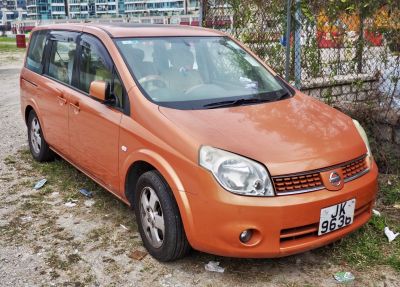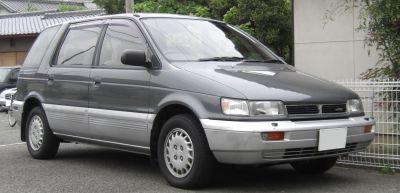 1998 Hyundai Santamo Dimensions, Size & Specs
1998 Hyundai Santamo Dimensions, Size & Specs
Measurements of the 1998 Hyundai Santamo, engineered for optimal performance and comfort
| Dimensions | |
|---|---|
| Length: | 4515 mm177.8 in14.8 ft |
| Width: | 1695 mm66.7 in5.6 ft |
| Height: | 1580 mm62.2 in5.2 ft |
| Trunk Capacity: | 210 liter7.4 cu ft |
| Trunk Capacity (Max): | 1715 liter60.6 cu ft |
| Weight Specifications | |
| Curb Weight: | 1460 kg3219 lbs |
| Maximal permitted Weight: | 2070 kg4564 lbs |
| Tire Specifications | |
| Rims Size: |
|
| Tire Size: |
|
The Hyundai Santamo, produced between 1998 and 2003, is a versatile minivan offering practicality and comfort tailored for family use and light commercial needs. This model measures 4515 mm (177.6 inches) in length, 1695 mm (66.7 inches) in width, and stands 1580 mm (62.2 inches) tall, positioning it comfortably within the compact minivan segment. Its curb weight is 1460 kg (3219 lbs), with a maximum weight capacity of 2070 kg (4563 lbs), showcasing a robust build suited for carrying passengers and cargo alike.
Inside, the Santamo provides a modest luggage capacity of 210 liters (7.4 cubic feet) with all seats in use, which significantly expands to 1715 liters (60.5 cubic feet) when the rear seats are folded down. This flexible storage option enhances the vehicle's functionality for varying cargo needs, from groceries to larger items. The car rides on 14-inch rims fitted with 195/70 R14 tires, which help deliver a stable and comfortable driving experience.
Overall, the Hyundai Santamo of this generation balances compact dimensions with ample interior space, making it an excellent choice for individuals seeking a reliable and spacious minivan that fits urban environments without sacrificing utility. Its size and configuration remain relevant to potential buyers looking for a mid-size MPV with practical luggage solutions and manageable footprint.
Discover the standout features that make the 1998 Hyundai Santamo a leader in its class
Have a question? Please check our knowledgebase first.
The Hyundai Santamo produced between 1998 and 2003 measures 4515 mm (177.6 inches) in length, 1695 mm (66.7 inches) in width, and 1580 mm (62.2 inches) in height. These dimensions position the Santamo firmly in the minivan segment, providing a balance of interior space while maintaining manageable external proportions for urban and suburban driving. Its length spans just over 4.5 meters, which is typical for compact to mid-size minivans of that era, enabling ease of parking and maneuverability. The width is slightly under 1.7 meters, ensuring the vehicle is narrow enough for narrow city streets but wide enough to comfortably seat multiple passengers side by side. The height helps provide ample headroom and allows for a commanding view of the road, a key attribute for minivan designs aimed at family and utility use.
The curb weight of the Hyundai Santamo ranges at about 1460 kilograms (3219 pounds), which reflects the weight of the vehicle without passengers or cargo but with all necessary fluids and a full tank of fuel. Its maximum weight capacity is 2070 kilograms (4562 pounds), indicating the total weight including cargo, passengers, and the vehicle itself. This means the Santamo can carry an additional load of roughly 610 kilograms (1343 pounds) safely, which is beneficial for families or users requiring good payload capacity. These weights suggest that the vehicle balances structural robustness with efficiency, lending itself to everyday use where moderate payload and passenger space are required without compromising drivability or fuel economy. The weight also impacts handling and braking; the Santamo's moderate curb weight offers stability without making the vehicle overly heavy or cumbersome.
The Hyundai Santamo has a luggage capacity of 210 liters (7.4 cubic feet) with the rear seats in place. This space is suitable for typical daily cargo needs such as groceries, bags, or small luggage. When the rear seats are folded down, the space expands dramatically to 1715 liters (60.6 cubic feet), allowing for much larger items or a significant amount of cargo. This flexibility is a key feature in minivans like the Santamo, making it versatile for different passenger and cargo configurations. The large folded capacity makes it possible to transport bulky items, furniture, or multiple travel bags, thus enhancing the practicality of the vehicle for family trips, moving, or commercial uses.
The Hyundai Santamo is equipped with 14-inch rims and tires sized 195/70 R14. This tire size provides a balanced profile that contributes positively to ride comfort and vehicle handling. The 70 aspect ratio indicates relatively tall sidewalls which help absorb road irregularities and reduce vibrations, enhancing comfort especially on less-than-perfect road surfaces. Tires sized 195 mm in width provide sufficient contact with the road to ensure stability without compromising fuel efficiency. The 14-inch wheel size was common for minivans of that era, offering a good compromise between ride quality and handling precision. These specifications support stable cornering, predictable steering, and a smooth ride, important traits for a family-oriented vehicle like the Santamo.
Yes, the Hyundai Santamo's dimensions make it suitable for most standard residential garages. With a length of 4515 mm (177.6 inches), width of 1695 mm (66.7 inches), and height of 1580 mm (62.2 inches), the Santamo fits well within typical garage sizes found in homes across many regions. Most standard garages offer at least 2.4 to 2.7 meters (8 to 9 feet) in width and 5.0 to 6.1 meters (16.4 to 20 feet) in length, which comfortably accommodates the Santamo with additional clearance for doors opening and maneuvering. The vehicle's moderate height also ensures it can fit without risk of roof contact in standard garage setups. Thus, owners can park their Santamo securely and conveniently at home without needing special accommodations.
The Hyundai Santamo offers a practical use of space within its exterior dimensions, optimized for passenger and cargo capacity. Although measuring 4515 mm in length and 1695 mm in width, the design emphasizes maximizing interior volume, especially given its minivan classification. The height of 1580 mm contributes to generous headroom, providing comfort for both front and rear passengers. The interior layout is typically flexible, allowing multiple seating arrangements with fold-flat rear seats to expand cargo space from 210 liters up to 1715 liters. Such versatility indicates thoughtful utilization of the Santamo's footprint to deliver space efficiency, making it suitable for families or users requiring adaptable transport solutions without a bulky exterior.
The Hyundai Santamo from 1998 to 2003 shares a similar size footprint with its predecessor models in the compact minivan segment but shows modest updates that enhance interior space usability and modernize the design. The length of 4515 mm, width of 1695 mm, and height of 1580 mm represent a balance between compactness and practicality, likely an evolution from previous generations where slight adjustments improved aerodynamics, cabin space, and ride comfort. Compared to earlier versions, the Santamo of this generation may have slightly increased dimensions to better compete in its market segment, adding improvements such as increased luggage capacity and passenger comfort without making the vehicle significantly larger. This incremental growth is common as manufacturers refine designs to better meet customer needs.
In comparison to other minivans from the late 1990s and early 2000s, the Hyundai Santamo offers competitive dimensions and features. Measuring 4515 mm in length and 1695 mm in width, it is slightly more compact than some larger minivans like the Chrysler Voyager or Renault Espace, which often exceeded 4700 mm in length and 1800 mm in width. However, the Santamo's size makes it more agile for urban environments and easier to park, which is attractive for European markets or urban centers with tighter parking. Its flexible seating and relatively large cargo capacity of up to 1715 liters with seats folded positions it well versus rivals. While it may have smaller engine options or less premium features compared to higher-end models, the Santamo offers good value with sufficient space, comfort, and practical features making it a solid choice in its category.
The Hyundai Santamo's size, weight, and cargo capacity make it well suited for families, small group transport, and light commercial uses. Its 4515 mm length and cargo space ranging from 210 liters up to 1715 liters with seats folded provide versatility for carrying passengers or larger items. The vehicle’s maximum weight capacity of 2070 kg ensures it can manage typical loads without strain. As a minivan, it’s commonly used for daily commuting with multiple passengers, weekend trips with luggage, or as a utility vehicle for small businesses needing to transport goods or equipment. The vehicle strikes a solid balance between cargo capacity and compactness, making it easy to drive in both city and highway environments.
The external dimensions of the Hyundai Santamo—4515 mm in length, 1695 mm in width, and 1580 mm in height—make it a relatively manageable vehicle for city driving and parking compared to larger minivans. Its sub-4.6-meter length is beneficial for navigating tighter urban streets, narrow lanes, and parking spaces where longer vans might struggle. The width just below 1.7 meters allows for easier maneuvering through traffic and detours often encountered in built-up areas. Furthermore, its height provides a good driving position without making it cumbersome for overhead clearances such as parking garages or low-hanging branches. Overall, the Santamo balances the functional space needs of a family or utility vehicle with the practicality required for everyday urban use.
Discover similar sized cars.

| Production: | 2004-2007 |
|---|---|
| Model Year: | 2005 |
| Length: | 4495 mm177.0 in |
| Width: | 1695 mm66.7 in |
| Height: | 1615 mm63.6 in |

| Production: | 1991-1998 |
|---|---|
| Model Year: | 1991 |
| Length: | 4515 mm177.8 in |
| Width: | 1695 mm66.7 in |
| Height: | 1615-1630 mm63.6-64.2 in |

| Production: | 1991-1997 |
|---|---|
| Model Year: | 1991 |
| Length: | 4515 mm177.8 in |
| Width: | 1695 mm66.7 in |
| Height: | 1580-1595 mm62.2-62.8 in |

| Production: | 1999-2004 |
|---|---|
| Model Year: | 1999 |
| Length: | 4515 mm177.8 in |
| Width: | 1695 mm66.7 in |
| Height: | 1620 mm63.8 in |
